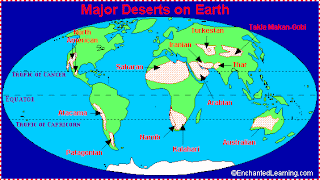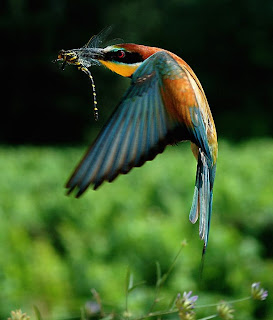Earth Series – Deserts

Alright, today’s Earth Series…The Desert. What’s to know? They’re dry, sandy places uninhabitable by living creatures, right? Of course you know that’s wrong. I say this because I trust you, my readers, to know better. But…did you know that they come in second, only to rainforests, for diversity of species? Among those species is us, the human being. While huge portions of desert are unoccupied by people there are those areas that have remained inhabited for tens of thousands of years. Another species that exists there, termites. These guys (and gals) play a pivotal role in a desert ecosystem. The air is too dry to support plant and wood eating fungi so the termites are the source of recycling, without them the ecosystem would collapse. The deserts of the world cover about 1/3 of its surface. They receive somewhere between 0 and 10 inches of rain per year. To put that into perspective, that’s how much rain we received here in South Bend within a 24 hour period after Ike blew its aftermath this way. None of the deserts on the face of the earth are completely lifeless, but there are areas within some deserts that are unable to support life. Nonetheless, life in a desert can be surprisingly evident. In most deserts many animals, reptiles, and insects are nocturnal due to the extreme heat and radiation of the daytime temperatures. The nighttime temperatures fall quickly. The lack of clouds allows the heat of the day to escape into the atmosphere. In the Sahara the temps can drop by 30 degrees. Some of the desert animals include species of fox, toads, scorpions, lizards, and bees. The Sahara even supports life for desert elephants and lions. They cannot survive in the large size herds and prides of the savannah, and they need to travel great distances to find food, but they are present.
The deserts of the world cover about 1/3 of its surface. They receive somewhere between 0 and 10 inches of rain per year. To put that into perspective, that’s how much rain we received here in South Bend within a 24 hour period after Ike blew its aftermath this way. None of the deserts on the face of the earth are completely lifeless, but there are areas within some deserts that are unable to support life. Nonetheless, life in a desert can be surprisingly evident. In most deserts many animals, reptiles, and insects are nocturnal due to the extreme heat and radiation of the daytime temperatures. The nighttime temperatures fall quickly. The lack of clouds allows the heat of the day to escape into the atmosphere. In the Sahara the temps can drop by 30 degrees. Some of the desert animals include species of fox, toads, scorpions, lizards, and bees. The Sahara even supports life for desert elephants and lions. They cannot survive in the large size herds and prides of the savannah, and they need to travel great distances to find food, but they are present.
So, speaking of the Sahara, it is the size of the United States. It is the world’s biggest source of sand and dust. Sandstorms, the size of Britain, occur without warning and may last for days. Single humped camels (Dromedaries) weather the storms there with little effort. As sands are blown around sand dunes are born. In the midst of these hazardous, life threatening conditions, though, sanctuary is sometimes found in the form of an oasis. These fountains of life exist where the ground water table is very close to the surface and water rises either in springs or is trapped in mountain hallows. 
 Getting back to the sand dunes here, some of the world’s largest are found in the Namibia desert. They can be as tall as 1,000 feet; grains of sand are blown up the flanks and across the crests of the ridges which means that only the tops of the dunes move. The main body of the dunes in Namibia has not shifted for 5,000 years. As the wind blows across the desert rocks, it carries sand which is continuously eroding the rock slowly turning it to more sand.
Getting back to the sand dunes here, some of the world’s largest are found in the Namibia desert. They can be as tall as 1,000 feet; grains of sand are blown up the flanks and across the crests of the ridges which means that only the tops of the dunes move. The main body of the dunes in Namibia has not shifted for 5,000 years. As the wind blows across the desert rocks, it carries sand which is continuously eroding the rock slowly turning it to more sand. The Australian desert has some of the hottest temperatures on earth. Every hour of the day the temperature rises 5 degrees centigrade reaching 70 degrees centigrade (158 degrees Fahrenheit) in the full sun.
The Australian desert has some of the hottest temperatures on earth. Every hour of the day the temperature rises 5 degrees centigrade reaching 70 degrees centigrade (158 degrees Fahrenheit) in the full sun.  The Atacama in Chile is the driest desert on earth; some parts of it haven’t seen rain for 50 years. Still, there is life here. South American camels (Guanacos) survive by eating cactus flowers which provides them with a source of water. But, how do the cacti survive without rain? Hot winds deprive the land of moisture but there is a cold sea current that runs parallel to the land. The cold water cools the air above and fog is made. The wind sweeps the fog inland blanketing the cacti with dew. Many various creatures are dependant on this, the only, source of water in an otherwise dry land. Birds drink the dew drops refreshing and rehydrating themselves. As the winds move inland, though, the air becomes too dry to condense and so there is only a small strip of the Atacama that can support life. Without the fog this portion of the desert would also be uninhabitable.
The Atacama in Chile is the driest desert on earth; some parts of it haven’t seen rain for 50 years. Still, there is life here. South American camels (Guanacos) survive by eating cactus flowers which provides them with a source of water. But, how do the cacti survive without rain? Hot winds deprive the land of moisture but there is a cold sea current that runs parallel to the land. The cold water cools the air above and fog is made. The wind sweeps the fog inland blanketing the cacti with dew. Many various creatures are dependant on this, the only, source of water in an otherwise dry land. Birds drink the dew drops refreshing and rehydrating themselves. As the winds move inland, though, the air becomes too dry to condense and so there is only a small strip of the Atacama that can support life. Without the fog this portion of the desert would also be uninhabitable.  The Sonoran Desert in Arizona sees more moisture. It receives infrequent and unpredictable rainfalls. Everything there must be ready to take advantage of it. Giant Saguaros, one of the largest cacti, use their large, shallow root systems to take up the water. The pleats on their trunks expand quickly and can store up to five tons of water. Woodpeckers nest in the trunks and the blooms of the saguaros provide food for migrating bats that would not be able to make it across the desert otherwise. BTW – many bats are now endangered throughout the world, and in our own back yard, including the Indiana bat. - This desert is home to some 3,000 plant species, 1,200 bee species, and more than 550 vertebrae species.
The Sonoran Desert in Arizona sees more moisture. It receives infrequent and unpredictable rainfalls. Everything there must be ready to take advantage of it. Giant Saguaros, one of the largest cacti, use their large, shallow root systems to take up the water. The pleats on their trunks expand quickly and can store up to five tons of water. Woodpeckers nest in the trunks and the blooms of the saguaros provide food for migrating bats that would not be able to make it across the desert otherwise. BTW – many bats are now endangered throughout the world, and in our own back yard, including the Indiana bat. - This desert is home to some 3,000 plant species, 1,200 bee species, and more than 550 vertebrae species.
Not all deserts are hot, the Gobi receives snow fall instead of rain. The range of temperature here makes this one of the harshest environments on the planet. The snow in the Gobi never melts, the air is too cold and dry and the suns rays evaporate it before it has the chance to become liquid. The snow is the only source of water in the Gobi. It is also home to Bactrian camels (two humps) one of the rarest animals on earth. 
Many deserts receive water from distant sources like mountains. The water from these places may run for a hundred miles or more causing a flash flood. It’s not called a flash flood due to an extreme amount of water, but rather because it only lasts for a flash. The water appears and then disappears in as little as the course of a day and only happens once, maybe twice a year. With the flood comes a renewal of vegetation that can support more life in turn. Some seeds may lie dormant in the soil for over 30 years, waiting for this moment. Some massive blooms occur as rarely as one time per century. The greenery will be short lived but it aids in the overall survival of all that inhabit the desert areas.




































